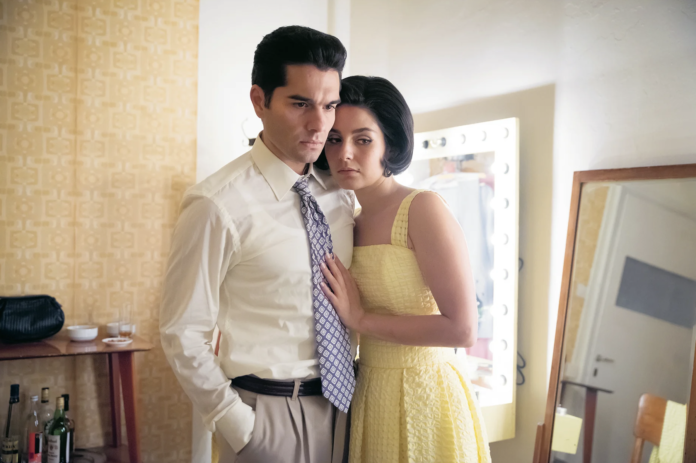F.W. Murnau’s 1922 Nosferatu: A Symphony of Horror (which San Francisco Silent Film Festival is presenting in a sold-out Fri/23 screening at Grace Cathedral) should by all rights be a “lost” film, like an estimated 90 percent of the silent era’s releases—though not for the usual reasons of neglect or decomposition, but rather by actual court order. Made a quarter-century after original publication of Dracula, and just a decade after its author’s death, the movie changed character names but otherwise held close to Bram Stoker’s narrative. Its makers didn’t bother securing the legal rights for that usage, however, so when Stoker’s widow got wise, she successfully sued for copyright violation.
By mid-1925, it was ruled that Nosferatu’s negative and all existing copies should be destroyed. Still, a few escaped that fate, so instead of becoming one of the most famous “lost” features of its era (like Tod Browning’s 1927 London After Midnight, another early example of vampire cinema), it gradually became one of the most famous surviving silents, period.
Over half a century later, Werner Herzog would create the first official remake, a visually rich, mannered, ideally cast (Klaus Kinski!) homage that was many things, if not very interested in being scary. Last year Robert Eggers contributed his version, which took an opposite tack—even if its magnificent atmosphere of dread unraveled somewhat once the bloodthirsty Count made it from the Carpathians to bourgeoise Germany.
But neither those remakes, or the innumerable screen Dracula incarnations starring Bela Lugosi, Christopher Lee, et al. have ever fully eclipsed Murnau’s. While some performance moments may feel antiquated now, it remains a more modern-feeling silent than we’re frequently used to: less sentimental, unusually straightforward in its horror aspects for the period, full of arresting imagery.
As tickets for the Grace Cathedral show at sundown (i.e. 8:15pm), accompanied by the Sascha Jacobsen Quintet, have already flown, we won’t dwell on the film further—beyond a passing lament for Murnau, whose death at age 42 in a 1931 car accident on the Pacific Coast Highway after he had been working in Hollywood for a few years deprived the medium of one of its greatest early artists. Rush tickets may be available at the door, though.
For some time afterward, movies often made a joke or a ruse out of similar themes, infrequently taking supernatural horror as seriously as Murnau had. It was considered a rather vulgar, juvenile genre, by the 1940s leading to such funfests as Frankenstein Meets the Wolf Man, or outright comedies like Abbott and Costello Meet Frankenstein. By then an adult’s idea of thrilling screen entertainment was anything by “master of suspense” Alfred Hitchcock, who himself had transitioned from his native England to Hollywood in 1939.
Any given decade of his long career is somebody’s idea of “the best,” but the series the Balboa Theater is hosting this Fri/23 through Mon/26 encompasses a lengthy golden era from Hitchcock’s early 1940s to mid-’60s—though Psycho and The Birds (arguably the director’s closest shaves with “horror”) are absent. Chronologically first is 1941’s Suspicion, a popular minor work trying to recapture the magic of the prior year’s Rebecca. But then there’s the excellent Shadow of a Doubt (1943), and 1954’s bravura Rear Window. Rope (1948) and Dial M For Murder (1954) were technical experiments that seem rather stagy now; To Catch a Thief (1955) and the next year’s Man Who Knew Too Much (a remake of his own 1934 film) were luxurious star vehicles.
The director was the real star (no matter how much he harried Cary Grant) in 1959’s espionage spectacular North by Northwest, a blueprint for so many subsequent action blockbusters. Ditto the more psychologically thorny, romantic-obsession likes of Vertigo (1960) and Marnie (1964). Hitchcock would live another 16 years and make a few more (mostly lesser) movies after that, but he’d already scaled the heights, artistically and otherwise—no director before or since acquired such marquee value. Does somebody out there have the stamina to binge-watch all 11 features in the Balboa’s extended-weekend program? Probably. Hitch has been dead nearly half a century now, but he’s still “box office.” The full schedule is here.
New movies opening this week:
Stelios
One of the most famous Greek singers of the 20th century, Stelios Kazantzidis grew up in poverty, becoming de facto head of his family at age 16 after his left-leaning father was killed by right-wing thugs in 1947. His powerful voice was such that when it stopped co-workers in their tracks, the owner of the factory where he labored gave him a guitar. Swiftly attracting further attention in nightclub gigs, he’d commenced a prominent recording career by the early 1950s, collaborating with esteemed composers and expanding the vocabulary of Greek popular song.
This handsomely produced biopic, with latterday pop star Christos Mastoras of the band Melisses as Stelios, provides a respectful, old-school portrait of the artist as reluctant celebrity and moody private individual. He’s loyal towards his hand-wringing widowed mother (Agoritsa Oikonomou), but resents her possessiveness; both controlling and distant towards the female singers (Klelia Renesi as Katy Gray, Asimenia Voulioti as Marinella) he becomes involved with romantically as well as professionally, ultimately driving them away. He dislikes the bourgeoise audiences he often plays for, and often clashes with the many record labels he signs to. He’d rather live a simple fishing life—yet the fame he runs away from keeps calling him back.
Billed up front as “a work of fiction based on” his life, Stelios is a respectable if not terribly inspired treatment of a legendary figure in the hands of director Yorgos Tsemberopoulos and screenwriter Katerina Bei. Those without extensive knowledge of modern Greek history and politics (like myself) may find it doesn’t do enough to explain the man or his era to international audiences. But it’s an effective tribute-introduction nonetheless, with plenty of music on tap (and a clip of the real-life subject on TV at the end). San Francisco Greek Film Festival is bringing it to the Delancey Street Screening Room this Fri/23 and Sat/24, with actress Vouliti in person—her performance has nabbed one of the film’s 10 Iris Award nominations from the Greek Film Academy. Ticket and event info is here.
Tour de France: ‘Jane Austen Wrecked My Life,’ ‘Holy Cow’
It’s pretty rare that a Greek film gets U.S. distribution, but even in our current dire straits for arthouses, French cinema remains a reliable source of imports. Two new features provide minor but satisfactory new wrinkles on familiar romantic-comedy and naturalistic drama templates.
Writer-director Laura Piani’s first feature Jane Austen Wrecked My Life draws on personal experience, in that like her heroine, she too once worked at the famous Paris bookstore Shakespeare & Co. But Agathe (Camille Rutherford) seems incapable of moving onward and upward, despite aspirations towards being a novelist herself. Nor can she seem to make any headway in her neglected love life, spurning the flirtatious overtures of a best friend-colleague (Pablo Pauly) while blaming her single status on expectations raised too-high by devotion to the titular 19th-century English scribe. When she’s urged to accept an invitation to an Austen-themed writers’ retreat in England, her sullen ways immediately grate against the equally dyspeptic demeanor of Mr. Darcy-like Oliver (Charlie Anson)—a recipe for mutual attraction, natch.
This is not exactly fresh territory, and Piani seems reluctant to truly embrace the rom-com conventions she’s nonetheless utilizing; charm and rooting value are hard to come by when your protagonist is this much of a self-absorbed drag. Still, people who like this sort of thing more than I do will probably find it pleasant and diverting, as it’s intended to be. The film opens Fri/23 at local venues including SF’s Metreon, Berkeley’s Elmwood, the Rafael Film Center, expanding farther on May 30.
Edgier to a degree is Louise Courvoisier’s own first directorial feature, Holy Cow, which is more in a mode of French-language, youth-centric neo-realism that’s stretched from Truffaut’s 400 Blows to the Dardenne Brothers and beyond. Totone (Clement Faveau) is a scrawny-but-surly teen who runs wild with his mates (Dimitry Baudry, Mathis Bernard) in a rural agricultural region of Jura, in eastern France. He also reluctantly does chores around his alcoholic father’s dairy farm, and mostly ignores motherless little sister Claire (Luna Garret). But that relatively carefree existence comes to an abrupt end when dad dies in a DUI crash, making Totone the sole breadwinner. He gets a job on a much larger, factory-farm operation, where unfortunately some coworkers are youths with whom he’s previously picked needless fights. But there’s also Marie-Lise (Maiwene Barthelemy), a tough-but-astute girl who spies something worthwhile beneath Totone’s often self-defeating, immature surface.
This coming-of-age saga is itself astute enough to soft-pedal the life lessons learned. Our hero becomes a better person not through any sentimental or melodramatic contrivance, but because he realizes crashing through life like a wrecking ball is not a viable long-term gameplan. (Look where it got his father.) Courvoisier was raised in this area, and her attention to everyday detail—Holy Cow is a crash course in cheese-making, among other things—is interesting as well as unforced. Ditto her handling of the actors, nearly all non-professional discoveries. It’s not a revelatory film, but it is expertly made, satisfying to watch, and more upbeat in the end than many of its ilk. It opens at SF’s Roxie Theater on Fri/23.
Unclassifiables: ‘Meanwhile,’ ‘Invention’
Two more experimental recent features are surfacing for individual local showings in the next few days, both with their filmmakers in attendance. Catherine Gund’s Meanwhile is a collaboration between the director, author Jacqueline Woodson, musician Meshell Ndegeocello, and others that constructs a quiet, poetical, digressive meditation on race and other ongoing/escalating sources of U.S. division. Weaving input from Toni Morrison, James Baldwin, and Nina Simone alongside currently practicing artists, athletes, et al., its mix of archival and new footage provides a contemplative space in which to consider reconciliation between individual, group, and national identities. It plays the Roxie Theater on Sun/25.
Courtney Stephens’ Invention blends narrative and documentary elements in telling the tale of a young woman who discovers her father—a figure not unlike co-writer/lead actress Callie Hernandez’s own late parent—left behind an electromagnetic supposed healing device. It was just one among many dubious discoveries and/or scams he pursued during his rather dodgy life. Attempting to settle the affairs of a very messy estate, she meets a variety of eccentric characters, including ones played by indie-cinema icons Caveh Zahedi and Joe Swanberg. Stephens too mixes archival and new material, to equally probing if more playful effect than Meanwhile. Her film plays Wed/28 at the Roxie, presented by San Francisco Cinematheque.





